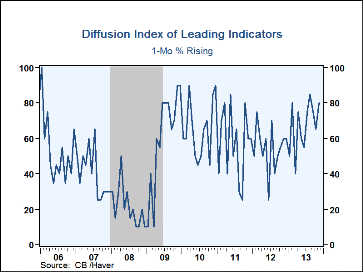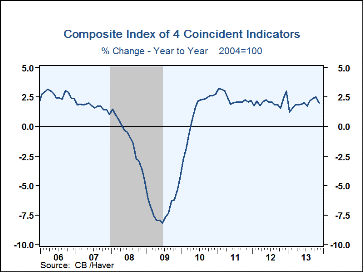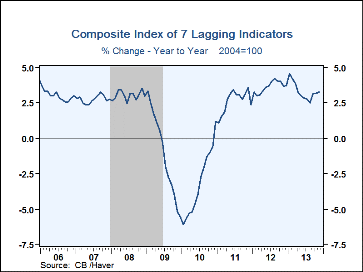 Global| Dec 19 2013
Global| Dec 19 2013U.S. Leading Economic Indicators Pick Up Last Month after October Pause
Summary
The index of Leading Economic Indicators, published by the Conference Board, was up 0.8% during November (5.2% y/y). That followed a modest 0.1% in October and was firmer than the 0.7% expected in the Action Economics Forecast Survey. [...]
The index of Leading Economic Indicators, published by the Conference Board, was up 0.8% during November (5.2% y/y). That followed a modest 0.1% in October and was firmer than the 0.7% expected in the Action Economics Forecast Survey. The breadth of component increase, that is, the diffusion index, also picked up last month, at 80% versus 65% in October. Among the components, a steepening in the interest rate yield curve and fewer initial unemployment insurance claims made the largest positive contributions. Other notable gains came from the ISM new orders index, the leading credit index and the S&P 500 stock index. The workweek in manufacturing and new orders for nondefense capital goods (ex aircraft) also added, while the only negative inputs came from building permits and consumer expectations for business conditions.
The ratio of coincident-to-lagging indicators, another leading indicator, rose to 89.4 in November from 89.1 in October. It measures how the economy is performing versus its excesses and is actually down 1.2% from November 2012.
The index of coincident indicators rose 0.4% (2.0% y/y) after just 0.1% in October. All four of its components - payroll employment, personal income less transfers, manufacturing & trade sales and industrial production - increased, with the biggest boost from industrial production.
The index of lagging economic indicators was flat last month (3.3% y/y) following a 0.3% rise in October. The positive items were led by the ratio of consumer installment credit to personal income and unit labor costs in manufacturing; a longer average duration of unemployment, somewhat weaker commercial and industrial loans and a slowing in the inflation rate of the CPI in services were the weakening offsets.
The Conference Board figures are available in Haver's BCI database; the components are available there, and most are also in USECON. The forecast figures for the Consensus are in the AS1REPNA database. Visit the Conference Board's site for coverage of leading indicator series from around the world.
| Business Cycle Indicators (%) | Nov | Oct | Sep | Y/Y | 2012 | 2011 | 2010 |
|---|---|---|---|---|---|---|---|
| Leading | 0.8 | 0.1 | 1.0 | 5.2 | 2.0 | 5.1 | 8.0 |
| Coincident | 0.4 | 0.1 | 0.3 | 2.0 | 2.1 | 2.4 | 1.2 |
| Lagging | 0.0 | 0.3 | 0.6 | 3.3 | 3.7 | 2.7 | -3.1 |
Carol Stone, CBE
AuthorMore in Author Profile »Carol Stone, CBE came to Haver Analytics in 2003 following more than 35 years as a financial market economist at major Wall Street financial institutions, most especially Merrill Lynch and Nomura Securities. She has broad experience in analysis and forecasting of flow-of-funds accounts, the federal budget and Federal Reserve operations. At Nomura Securites, among other duties, she developed various indicator forecasting tools and edited a daily global publication produced in London and New York for readers in Tokyo. At Haver Analytics, Carol is a member of the Research Department, aiding database managers with research and documentation efforts, as well as posting commentary on select economic reports. In addition, she conducts Ways-of-the-World, a blog on economic issues for an Episcopal-Church-affiliated website, The Geranium Farm. During her career, Carol served as an officer of the Money Marketeers and the Downtown Economists Club. She has a PhD from NYU's Stern School of Business. She lives in Brooklyn, New York, and has a weekend home on Long Island.









